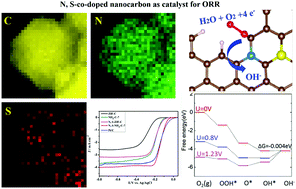当前位置:
X-MOL 学术
›
Mater. Horiz.
›
论文详情
Our official English website, www.x-mol.net, welcomes your
feedback! (Note: you will need to create a separate account there.)
Origin of the high oxygen reduction reaction of nitrogen and sulfur co-doped MOF-derived nanocarbon electrocatalysts
Materials Horizons ( IF 12.2 ) Pub Date : 2017-06-23 00:00:00 , DOI: 10.1039/c7mh00244k Zhongxin Song 1, 2, 3, 4 , Weiwei Liu 5, 6, 7 , Niancai Cheng 1, 2, 3, 4 , Mohammad Norouzi Banis 1, 2, 3, 4 , Xia Li 1, 2, 3, 4 , Qian Sun 1, 2, 3, 4 , Biwei Xiao 1, 2, 3, 4 , Yulong Liu 1, 2, 3, 4 , Andrew Lushington 1, 2, 3, 4 , Ruying Li 1, 2, 3, 4 , Limin Liu 5, 6, 7 , Xueliang Sun 1, 2, 3, 4
Materials Horizons ( IF 12.2 ) Pub Date : 2017-06-23 00:00:00 , DOI: 10.1039/c7mh00244k Zhongxin Song 1, 2, 3, 4 , Weiwei Liu 5, 6, 7 , Niancai Cheng 1, 2, 3, 4 , Mohammad Norouzi Banis 1, 2, 3, 4 , Xia Li 1, 2, 3, 4 , Qian Sun 1, 2, 3, 4 , Biwei Xiao 1, 2, 3, 4 , Yulong Liu 1, 2, 3, 4 , Andrew Lushington 1, 2, 3, 4 , Ruying Li 1, 2, 3, 4 , Limin Liu 5, 6, 7 , Xueliang Sun 1, 2, 3, 4
Affiliation

|
Developing an economical, highly active and durable material to replace the conventional, expensive noble metal electrocatalyst is an important milestone in the development of fuel cell technology. Nanocarbon materials are considered as promising catalysts toward the oxygen reduction reaction (ORR) in fuel cells, due to their reasonable balance between low-cost, long-life durability and high catalytic activity in alkaline media. In this work, we present the fabrication of N,S-co-doped nanocarbon derived from a metal-organic framework (MOF) precursor for use as an electrocatalyst towards ORR. High resolution transmission electron microscopy (HRTEM) mapping demonstrates the uniform distribution of N and S atoms into the nanocarbon skeleton. The nitrogen absorption–desorption isotherms indicate that the MOF-derived N,S-co-doped nanocarbon has a high specific surface area (2439.9 m2 g−1) and a porous structure. Importantly, the N,S-co-doped nanocarbon exhibits higher catalytic activity toward ORR, better long-term stability and methanol tolerance than commercial Pt/C catalyst. First-principles calculations demonstrate that the remarkable electrochemical properties of N,S-co-doped nanocarbon are mainly attributed to the synergistic effect from the N and S dopants. Moreover, for the first time, it is revealed that the N,S-coupled dopants in nanocarbon can create active sites with higher catalytic activity for ORR than the isolated N and S-dopants. This finding on the structure–performance relationship of the co-doped nanocarbon provides guidelines for the design of high performance electrocatalysts.
中文翻译:

氮和硫共掺杂MOF衍生的纳米碳电催化剂高氧还原反应的起源
开发经济,高活性和耐用的材料来替代传统的昂贵的贵金属电催化剂是燃料电池技术发展的重要里程碑。纳米碳材料因其在低成本,长寿命耐久性和在碱性介质中的高催化活性之间的合理平衡而被认为是燃料电池中进行氧还原反应(ORR)的有前途的催化剂。在这项工作中,我们介绍了由金属有机骨架(MOF)前体衍生的N,S共掺杂的纳米碳的制备,该碳用作ORR的电催化剂。高分辨率透射电子显微镜(HRTEM)映射证明了N和S原子在纳米碳骨架中的均匀分布。氮吸收-解吸等温线表明,MOF衍生的氮,2克-1)和一个多孔结构。重要的是,与市售Pt / C催化剂相比,N,S共掺杂的纳米碳对ORR表现出更高的催化活性,更好的长期稳定性和甲醇耐受性。第一性原理计算表明,N,S共掺杂的纳米碳的卓越电化学性能主要归因于N和S掺杂剂的协同作用。此外,首次揭示了纳米碳中的N,S偶联掺杂剂可以创建比分离的N和S掺杂剂具有更高的ORR催化活性的活性位点。共掺杂纳米碳的结构-性能关系的这一发现为高性能电催化剂的设计提供了指导。
更新日期:2017-08-03
中文翻译:

氮和硫共掺杂MOF衍生的纳米碳电催化剂高氧还原反应的起源
开发经济,高活性和耐用的材料来替代传统的昂贵的贵金属电催化剂是燃料电池技术发展的重要里程碑。纳米碳材料因其在低成本,长寿命耐久性和在碱性介质中的高催化活性之间的合理平衡而被认为是燃料电池中进行氧还原反应(ORR)的有前途的催化剂。在这项工作中,我们介绍了由金属有机骨架(MOF)前体衍生的N,S共掺杂的纳米碳的制备,该碳用作ORR的电催化剂。高分辨率透射电子显微镜(HRTEM)映射证明了N和S原子在纳米碳骨架中的均匀分布。氮吸收-解吸等温线表明,MOF衍生的氮,2克-1)和一个多孔结构。重要的是,与市售Pt / C催化剂相比,N,S共掺杂的纳米碳对ORR表现出更高的催化活性,更好的长期稳定性和甲醇耐受性。第一性原理计算表明,N,S共掺杂的纳米碳的卓越电化学性能主要归因于N和S掺杂剂的协同作用。此外,首次揭示了纳米碳中的N,S偶联掺杂剂可以创建比分离的N和S掺杂剂具有更高的ORR催化活性的活性位点。共掺杂纳米碳的结构-性能关系的这一发现为高性能电催化剂的设计提供了指导。











































 京公网安备 11010802027423号
京公网安备 11010802027423号